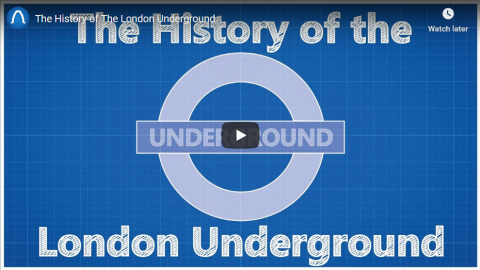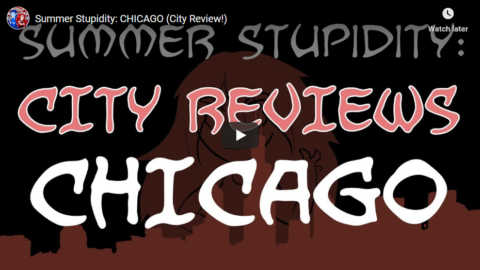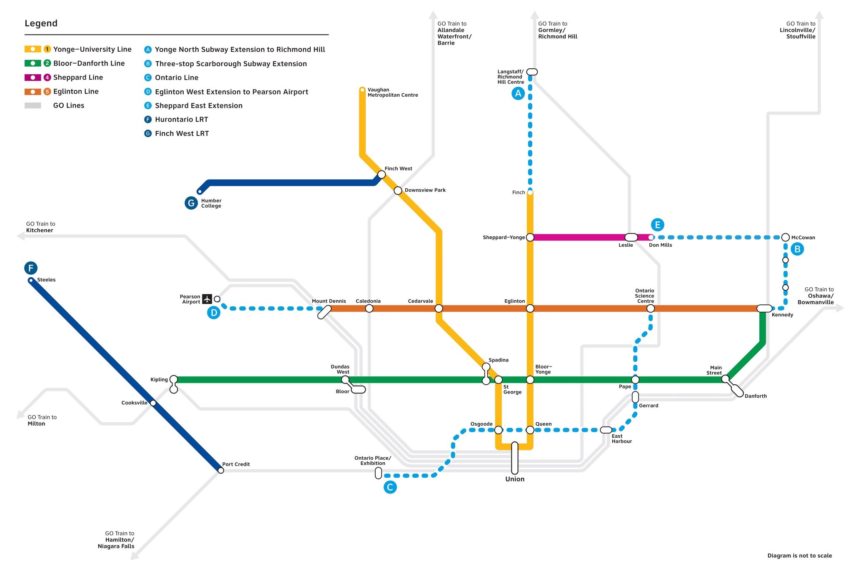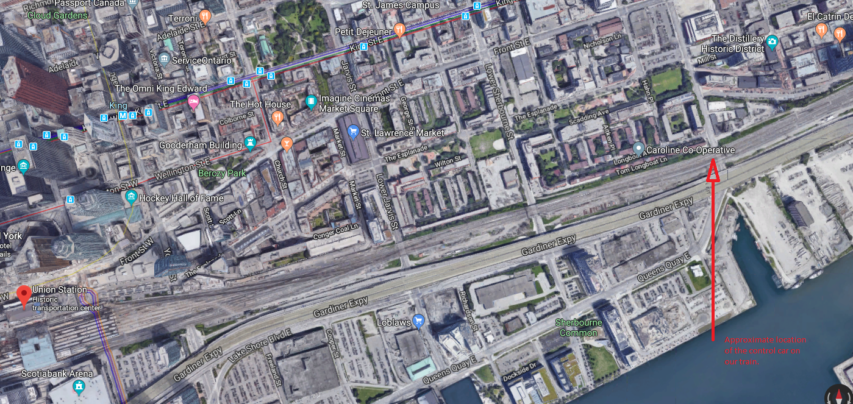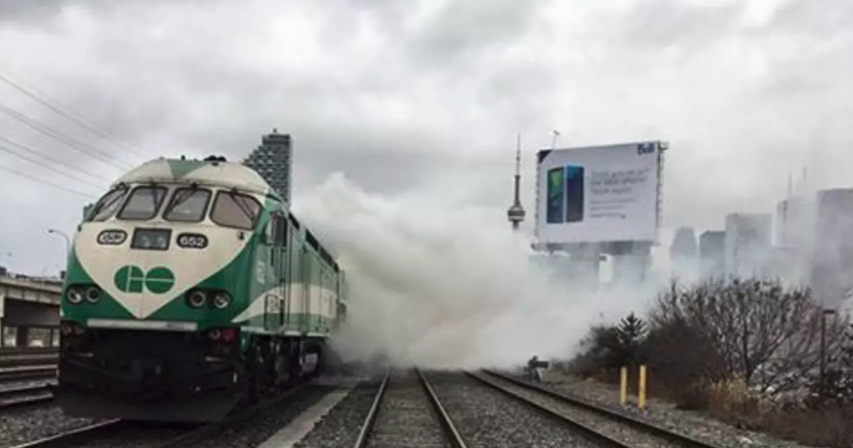Real Engineering
Published on 29 Dec 2017
October 7, 2019
The History of The London Underground
July 24, 2019
Summer Stupidity: COPENHAGEN (City Review!)
Overly Sarcastic Productions
Published on 23 Jul 2019It’s Copenhagen time! Hop on your bike and ride around one of Europe’s fanciest cities.
PATREON: https://www.Patreon.com/OSP
MERCH LINKS: https://www.redbubble.com/people/OSPY…
OUR WEBSITE: https://www.OverlySarcasticProductions.com
Find us on Twitter https://www.Twitter.com/OSPYouTube
Find us on Reddit https://www.Reddit.com/r/OSP/
July 10, 2019
Summer Stupidity: CHICAGO (City Review!)
Overly Sarcastic Productions
Published on 9 Jul 2019O Chicago, a city near and dear to my heart. And not just because I have a healthy respect for pizza that’s functionally pie.
PATREON: https://www.Patreon.com/OSP
OUR WEBSITE: https://www.overlysarcasticproductions.com/
Find us on Twitter https://www.Twitter.com/OSPYouTube
Find us on Reddit https://www.Reddit.com/r/OSP/
June 26, 2019
Summer Stupidity: LONDON (City Review!)
Overly Sarcastic Productions
Published on 25 Jun 2019For more summer fun, we’re heading to London! Let us know what other fun side-content you’d like to see. We’ll see you with more long-form content on Friday!
PATREON: https://www.Patreon.com/OSP
OUR WEBSITE: https://www.OverlySarcasticProduction…
Find us on Twitter https://www.Twitter.com/OSPYouTube
Find us on Reddit https://www.Reddit.com/r/OSP/
June 19, 2019
Summer Stupidity: NEW YORK (City Review!)
Overly Sarcastic Productions
Published on 18 Jun 2019Welcome to summer break! We’re beta-testing a new kind of video to punctuate our REAL weekly Friday content on lazy summer Tuesdays. Let us know if this brand of fast-talking stupidity is something you’d potentially like to see more of! As always, regular content returns Friday.
PATREON: http://www.Patreon.com/OSP

April 12, 2019
Premier Ford “could go down in history as the premier who landed downtown Torontonians their white whale subway”
Chris Selley finds himself surprised at how sane Doug Ford’s GTA subway-and-light-rail expansion plans sound:
I’ll say this much at least about Premier Doug Ford’s big $28.5 billion transit announcement on Wednesday morning ($11.2 billion if you only count provincial money): I never thought I would see him so enthusiastically tout a much-needed transit line to and through enemy territory in downtown Toronto. Faint praise, perhaps, but when Ford said he wanted to upload Toronto’s subways to the province, I never imagined a plan even half this superficially sane.
Crowding on the Yonge line at Bloor Street presents “a clear health and safety problem,” Ford told reporters in Etobicoke, “and without action it is only going to get worse.” Thus his number-one transit priority is the same as everyone else’s: the Downtown Relief Line, which the PC government has wisely redubbed the Ontario Line.
The most basic and essential piece of that line, which Toronto city staff are already working on, would connect City Hall with Pape station on Danforth. Passengers who live in the east end and work downtown could thus avoid the bottleneck at Yonge and Bloor, relieving the alarming rush hour situation on platforms there and — assuming new TTC signalling technology works as promised — freeing up southbound capacity for folks from York Region: Ford vows to extend the Yonge line to Richmond Hill (cost: $5.6 billion).
The order here matters more than the timeline (2027, supposedly). It is undisputed that the DRL has to happen before the extension. That’s basic knowledge. But Ford is capable of ignoring or fouling up very basic knowledge when stumping for subways. This is a man who nearly promised Pickering one. On Wednesday, he sounded remarkably well briefed.
Ford’s Ontario Line wouldn’t stop at Danforth and City Hall, either. In the east it would head north across the Don Valley, through Thorncliffe Park and up to Eglinton. This idea is nearly as old as the DRL itself. And it would jog southwest from downtown to Ontario Place — a novelty, but again, not crazy. Total cost for the line: an at least semi-plausible $11.2 billion.
April 11, 2019
Ontario government unveils massive subway and light rail expansion for the GTA
Doug Ford has always been a fan of subways, but now that he’s the Premier of Ontario, he’s getting to indulge his subway fetish in a vast expansion to heavy and light rail transit in and around Toronto:
The plans include:
- An expanded downtown relief line, now to be called the Ontario line, running from Ontario Place on the lakeshore through downtown along Queen Street then crossing the Bloor-Danforth subway line at Pape station and running north to the Ontario Science Centre on the Eglinton Crosstown LRT line. This line is optimistically to be ready for opening by 2027.
- The existing Sheppard Line will be extended east from Don Mills to McCowan, where it will intersect with the planned Scarborough subway extension (now to include three stops, not just the one originally announced, and to be completed by 2030).
- The Yonge-University line will be extended north from current terminus at Finch to the Richmond Hill Centre with a hoped-for completion date soon after the Ontario line.
- The Eglinton Crosstown line will be extended west to Pearson airport, with a target completion date of 2031.
- New light rail lines will be created between Finch West on the Yonge-University subway to Humber College, and along Hurontario Street in Mississauga from Port Credit on the lakeshore to Steeles Avenue in Brampton.
To accomplish all of this will require financial contributions from the City of Toronto, York Region, and the federal government, as the province is only funding just over one third ($11.2 billion) of the estimated $28 billion price tag.
Of course, it’s a Doug Ford plan, so none of the usual suspects in Toronto are happy about any of it.
February 27, 2019
Toronto’s transit cheat epidemic
I knew the Toronto Transit Commission (TTC) had an issue with fare evasion, but I had no idea it was as prevalent as this:
Anyone who has ever sat through a Toronto Transportation Commission meeting has likely heard anecdotal evidence that fare evasion on the transit system is utterly rampant, if not a mockery of Western civilization itself. Traditionally, such people tended to be treated as harmless cranks. TTC staff would placate them with various internal audits conducted over the years that found roughly two-per-cent fare loss. As recently as 2017, the TTC was claiming just 1.8 per cent of passengers on streetcars — where it’s easiest not to pay — weren’t ponying up.
Well, so much for that. In a convincing report issued last week based on 136 hours of in-person observation and 38 hours of security footage, city auditor-general Beverly Romeo-Beehler estimates fare evasion rates at 15.2 per cent on streetcars, 5.1 per cent on buses and 3.7 per cent on subways, for a total weighted average of 5.4 per cent— around $61 million a year, plus roughly $3.4 million thanks to malfunctioning Presto card equipment owned by Metrolinx.
To put that in perspective, last year’s average 3.2-per-cent fare increase was projected to add $17 million to TTC coffers. If the AG is right, commuters are paying something like 12 cents per trip to subsidize free riders. And the problems underlying the issue are nothing short of jaw-dropping. For one thing, the auditor-general’s team observed scores of adults — and precisely zero children — using child Presto cards to ride for free.
January 8, 2019
A typical commute
I had to go into Toronto on Monday, and the address was near Queen and Yonge, so I could take the GO train most of the way (which means I could at least get some reading done during the train trip). Getting there wasn’t as easy as I’d hoped, as the traffic on the 401 was slow-to-stopped as I got on, but the sliproad to the next exit was moving even slower than the main highway. Once we got past the turnoff, the speed increased up to slow-but-steady for a few kilometres. Up ahead, there were flashing red and blue lights. I figured there was an accident, so I switched lanes away from what appeared to be the accident site. But it wasn’t an accident, at least not by most definitions. In the eastbound lanes, there were what appeared to be a full dozen police vehicles, surrounding a black car that looked like it’d pinballed against the concrete lane dividers a few times before coming to a stop. Just as I was passing the epicentre, I saw a police officer escorting a handcuffed man from the vehicle toward one of the police cars.
With that delay, we’d pretty much missed the chance to catch the original GO train we’d planned on, but there was another scheduled to arrive about fifteen minutes later which we could still catch.
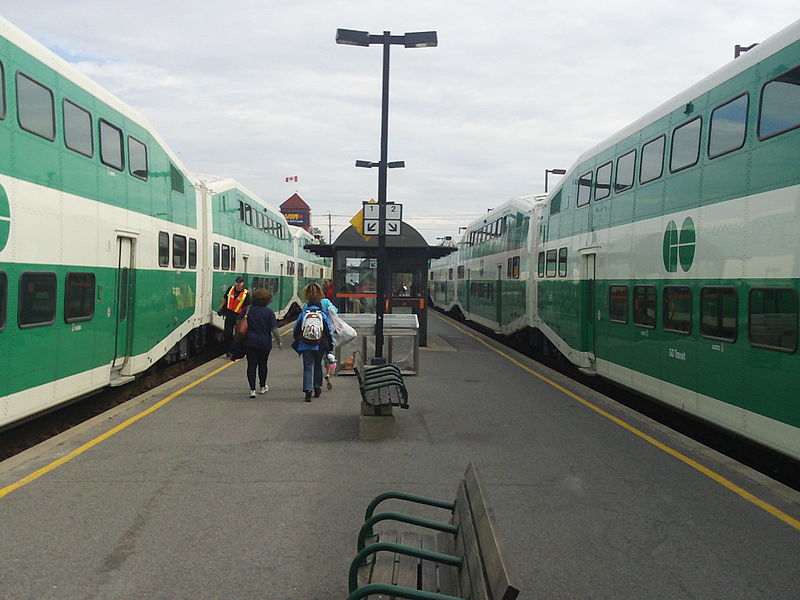
The platform at Oshawa GO station. The parking situation is insane at Oshawa, so I usually drive one stop west and park at Whitby GO instead.
Photo by Anthony Easton via Wikimedia Commons
Nearing the end of our journey, the lights in the car went out and the train coasted to a stop right in the yard throat of Toronto’s Union Station. For several minutes, there was no information from the conductor — sorry, the “Customer Service Ambassador” — but then he announced that we all needed to move along the train “in the opposite direction the train is travelling” to car number 2xxx. We all got up and shuffled through the train passing through several bilevel cars until we started to smell smoke … the conductor had sent us in the wrong direction and we’d been walking toward the fire, not away from it. We could also see some grey smoke being blown toward us from the locomotive end of the train, so it didn’t take much to persuade everyone that we needed to walk to the front of the train instead.
There seemed to be a lot of sirens approaching the train, as the emergency services were dispatched, and no other trains could get into or out of the east end of Union Station for over an hour while we sat in the slowly cooling control car at the west end of the train. Eventually, they were able to get a crew to bring out another train for us to transfer into and they took us the kilometer or so into Union, ninety minutes late.
blogTO had a few photos of the end of the train we couldn’t see:
A GO Train was on fire in #Toronto earlier today https://t.co/EgkEmBPyHx – Video by Ali Al Astarabadi pic.twitter.com/BIGUitgflZ
— blogTO (@blogTO) January 7, 2019
After those two incidents, I was wondering if the universe was trying to tell us we shouldn’t have gone into Toronto after all…
September 3, 2018
Planes, Trains, and… Actually, just Trains
Knowing Better
Published on 18 Sep 2016The railroad has affected your life more than you may have realized. From starting the mail order business to creating some of America’s greatest landmarks, see how this simple transportation system shaped the country we live in today.
Patreon ► http://patreon.com/knowingbetter
Twitter ► https://twitter.com/KnowingBetterYT
Facebook ► https://facebook.com/KnowingBetterYT/
Reddit ► https://reddit.com/r/KnowingBetter/—
Why Trains Suck in America – Wendover Productions – https://youtu.be/mbEfzuCLoAQ
Photo Credits –
American Waterways/Canals are edits of images I used to teach in 2011 – The originals were from Wikicommons and have long since been removed or updated. No Copyright Information can be found.
The Three Proposed Railroad Routes are edits of images I used to teach in 2013 – The originals were from Wikicommons and have long since been removed or updated. No Copyright Information can be found.
I don’t normally add comments about the daily 2:00am videos, but there are a couple of things in this video that I think needed to be addressed. First, he rather casually skips over the vast increase in American railway building even before the enabling legislation for the transcontinental lines, and misses a great opportunity to explain how important they were in determining the outcome of the American Civil War. Second, and rather more irritatingly, he blithely asserts the common myth about the “Big Oil” conspiracy to buy up and shut down municipal light rail (streetcars, interurban railways, and radials). The various streetcar systems had almost all been economically shaky since the Great Depression (many had to be taken over by the municipalities involved to keep them out of bankruptcy), and the huge increase in private car ownership after World War 2 was the coup de grâce that finished off most of the rest. During the same time, bus routes were encroaching on the streetcar’s territory and had the huge advantage of not being tied to rails (allowing relatively easy re-routing without huge construction costs).
May 7, 2018
Study: climate change skeptics behave in a more environmentally friendly manner than believers
In common with some similar observed phenomena, people who like to signal their climate change beliefs are actually less likely to act in environmentally beneficial ways than declared climate skeptics. At Pacific Standard, Tom Jacobs details the findings of a recent study:
Do our behaviors really reflect our beliefs? New research suggests that, when it comes to climate change, the answer is no. And that goes for both skeptics and believers.
Participants in a year-long study who doubted the scientific consensus on the issue “opposed policy solutions,” but at the same time, they “were most likely to report engaging in individual-level, pro-environmental behaviors,” writes a research team led by University of Michigan psychologist Michael Hall.
Conversely, those who expressed the greatest belief in, and concern about, the warming environment “were most supportive of government climate policies, but least likely to report individual-level actions.”
Sorry, I didn’t have time to recycle — I was busy watching a documentary about the crumbling Antarctic ice shelf.
The study, published in the Journal of Environmental Psychology, followed more than 400 Americans for a full year. On seven occasions — roughly once every eight weeks — participants revealed their climate change beliefs, and their level of support for policies such as gasoline taxes and fuel economy standards.
They also noted how frequently they engaged in four environmentally friendly behaviors: recycling, using public transportation, buying “green” products, and using reusable shopping bags.
The researchers found participants broke down into three groups, which they labeled “skeptical,” “cautiously worried,” and “highly concerned.” While policy preferences of group members tracked with their beliefs, their behaviors largely did not: Skeptics reported using public transportation, buying eco-friendly products, and using reusable bags more often than those in the other two categories.
April 22, 2018
How to begin solving the common problems of big cities
Vladimir “Zeev” Vinokurov is writing about Australian cities in particular, but the same general analysis applies to many Canadian, American, and British urban areas as well:
… our economy and population are growing, and the resulting congestion is costing us thousands of dollars per year individually, and billions to the economy. It isolates us from family, friends and work. But cities can still grow without getting us stuck in traffic, missing increasingly overcrowded and delayed trains, or left unable to afford property. All this is happening because workplaces are too far from residents living in the suburbs, which effectively funnels residents into the inner city for work. It must change.
First, we must unwind planning laws that prevent offices, homes and apartments from being constructed alongside each other and throughout the city. These laws also raise housing prices by hundreds of thousands of dollars. Second, instead of banning cars, charge commuters for using congested roads and trains. Third, stop supporting taxpayer funded ‘road to nowhere’ infrastructure projects. These reforms will cut congestion, grow the economy, cut living costs and reconnect us to family, friends and local communities.
Planning laws cause congestion and social isolation by preventing people from building apartments and commercial offices throughout our city. As a result, rents and property prices become dearer because not enough housing is built to accommodate demand from population growth. Indeed, Reserve Bank economists estimate that planning laws increase average property prices by hundreds of thousands of dollars. This drives residents into the outer suburbs to look for cheaper housing, even as they commute into the inner city for work. If more people lived close-by to their workplaces, commutes would be shorter.
We need multiple CBDs, not just one. Unwinding planning laws that prevent commercial growth outside the CBD will cut housing costs and rents, cut congestion and promote tightly knit, thriving urban communities.
Congestion also occurs because we pay for using roads and public transport with thousands of dollars of time every year, rather than money. Congested public roads or trains cost us no more money to use in peak times, and busier routes cost no more to use than empty ones. As a result, the Grattan Institute think tank estimates that the average Melbournian’s commute to the city is twice as long in peak time. By contrast, Sydney’s trains are less congested, but are used more widely compared to Melbourne’s because its tickets are dearer in rush hour. Congestion charges that reflect market demand for infrastructure will also encourage businesses to open in commercial districts outside the CBD. Reconnecting local commuters with local workplaces will save us time and money overall.
Congestion charges are also a fairer and cheaper way of funding infrastructure projects compared to taxes like fuel tax or stamp duty. Scrapping these two taxes could save property purchasers tens of thousands of dollars or more, and reduce petrol bills by at least a third. If we pay for congested roads and trains with money rather than time and taxes, we may end up paying less.
December 7, 2017
Lawrence Solomon makes his pitch for “most hated by the bike mafia”
This was published last week, but I didn’t see it until it was linked from Instapundit:
Today the bicycle is a mixed bag, usually with more negatives than positives. In many cities, bike lanes now consume more road space than they free up, they add to pollution as well as reducing it, they hurt neighbourhoods and business districts alike, and they have become a drain on the public purse. The bicycle today — or rather the infrastructure that now supports it — exemplifies “inappropriate technology,” a good idea gone wrong through unsustainable, willy-nilly top-down planning.
London, where former mayor Boris Johnston began a “cycling revolution,” shows where the road to ruin can lead. Although criticism of biking remains largely taboo among the city’s elite, a bike backlash is underway, with many blaming the city’s worsening congestion on the proliferation of bike lanes. While bikes have the luxury of zipping through traffic using dedicated lanes that are vastly underused most of the day — these include what Transport for London (TfL) calls “cycle superhighways” — cars have been squeezed into narrowed spaces that slow traffic to a crawl.
As a City of London report acknowledged last year, “The most significant impact on the City’s road network in the last 12 months has been the construction and subsequent operation of TfL’s cycle super highway … areas of traffic congestion can frequently be found on those roads.” As Lord Nigel Lawson put it in a parliamentary debate on bicycles, cycle lanes have done more damage to London than “almost anything since the Blitz.”
As a consequence of the idling traffic, pollution levels have risen, contributing to what is now deemed a toxic stew. Ironically, cyclists are especially harmed, and not just because the bike lanes they speed upon are adjacent to tailpipes. According to a study by the London School of Medicine, cyclists have 2.3 times more inhaled soot than walkers because “cyclists breathe more deeply and at a quicker rate than pedestrians while in closer proximity to exhaust fumes … Our data strongly suggest that personal exposure to black carbon should be considered when planning cycling routes.” Cyclists have begun wearing facemasks as a consequence. A recent headline in The Independent helpfully featured “5 best anti-pollution masks for cycling.” Neighbourhoods endure extra pollution, too, with frustrated autos cutting through residential districts to avoid bike-bred congestion.
Health and safety costs aside — per kilometre travelled, cyclist fatalities are eight times that of motorists — the direct economic burden associated with cycling megaprojects is staggering. Paris, which boasts of its plan to become the “cycling capital of the world,” is in the midst of a 150-million-euro cycling scheme. Melbourne has a $100-million plan. Amsterdam — a flat, compact city well suited to cycling — is spending 120 million euros on 9,000 new bicycle parking spots alone. Where cold weather reigns for much of the year, as is the case in many of Canada’s cities, the cost-benefit case for cycling infrastructure is eviscerated further.
An answer might be dedicated bicycle-only routes, but the usual problem arises: the cost of the land necessary to build and maintain the routes will almost always be far higher than municipalities can afford to pay, and the benefits accrue more to upper-income users while the costs fall on the whole population. That’s just what we need: another way to transfer wealth from the poor to the rich.
September 25, 2017
London’s foolish Uber ban
Iain Murray on the decision by London bureaucrats (backed by the Lord Mayor) to ban Uber in favour of established cab companies:
When I lived in London in the 1990s, I had to use pricey Black Cabs to get around the city at night. However, heaven help you if you wanted to go South of the Thames (as I did when I lived there) after midnight – Black Cabs would just refuse to take you. On one occasion I watched in horror as the cab driver got out and literally started a fight with a driver who had cut him off – and he kept the meter running throughout the fracas.
London’s days of high prices, uncertainty, and danger ended when Uber started operating there in 2012. It went on to dominate the London private hire car market. Today, that was all thrown out as Transport for London (TfL), an Uber competitor in that it runs the Tube and franchises bus services, revoked Uber’s license to operate.
Safety First?
The decision was ostensibly based on health and safety grounds. TfL said:
“TfL considers that Uber’s approach and conduct demonstrate a lack of corporate responsibility in relation to a number of issues which have potential public safety and security implications. These include:
- Its approach to reporting serious criminal offences.
- Its approach to how medical certificates are obtained.
- Its approach to how Enhanced Disclosure and Barring Service (DBS) checks are obtained.
- Its approach to explaining the use of Greyball in London – software that could be used to block regulatory bodies from gaining full access to the app and prevent officials from undertaking regulatory or law enforcement duties.”
These grounds are puzzling. Uber has a dedicated team responsible for working with the police regarding incidents with cars that use the Uber app – something London’s Black Cabs lack. Uber’s drivers go through exactly the same background checks and approval processes that Black Cab drivers do. And Uber denies that the Greyball feature has ever been used in London.
Moreover, accusations of violence, especially sexual violence, by Uber app drivers are overblown. As Reuters reports, “Of the 154 allegations of rape or sexual assault made to police in London between February 2015 and February 2016 in which the suspect was a taxi driver, 32 concerned Uber, according to the capital’s police force.” If Uber was uniquely bad in having drivers who attempted sexual assaults, that share should be much higher.
On Saturday night, Perry de Havilland reported on the petition to rescind the TfL decision:
The #SaveYourUber petition has, as of 10:45 pm in London, attracted 600,000+ names, and one of them is mine.
Of course the best way to save Uber is to get rid of Sadiq Khan and make the issue politically radioactive.

